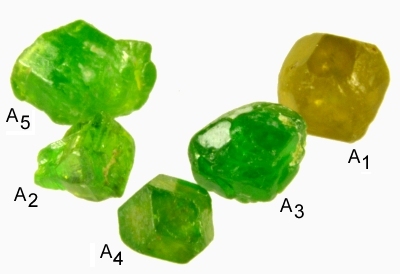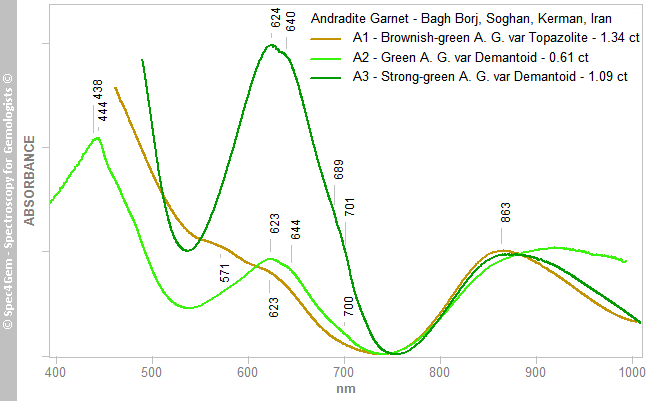Demantoid and Topazolite, andradite garnet from Bagh Borj, Soghan, Kerman, Iran
- Details
- Created: Saturday, 22 July 2017 10:58
Since mid-2001, attractive crystals of demantoid have been mined from the Kerman province in southeastern Iran. The mines are located nearby Soghan city and especially in the moutains close to Bagh Borj village. Yellowish-green to green, brownish-green to brown single crystals and crystal clusters as large as 2–3 cm have been produced, although most range from 2 to 10 mm in diameter. The clusters form rounded translucent aggregates, whereas the single crystals are typically transparent in smaller sizes (i.e., 2–3 mm) and semitransparent to translucent in larger sizes[1][3][4]. Rare cat's-eye specimen have been found[2]. The samples of figure 1 are quite recent finds (2016/7). A1, A3 and A4 are crystals although A2 and A5 are crystal parts. Colors vary from slightly-yellowish-green to strong-green to brownish-green or brownish-yellow.
 Figure 1. Three crystals (A1, A3, A4) and two broken crystals (A2, A5)
Figure 1. Three crystals (A1, A3, A4) and two broken crystals (A2, A5)from Bagh Borj village, Soghan district, Kerman province, Iran
| Shape | rhombic dodecahedron crystal or part of |
| Size | 3 to 5 mm |
| Color | A2 & A5: slightly-yellowish-green, A4: green, A3: strong-green, A1: brownish-green or brownish-yellow |
| Lustre | vitreous |
| Weight | A1: 1.34 ct, A2: 0.61 ct, A3: 1.00 ct, A4: 0.62 ct, A5: 1.09 ct |
| SG | A1: 3.83, A2, A3, A4 & A5 (all together): 3.85 |
| RI | OTL > 1.79 |
| DR | not applicable |
| Pleochroism | not applicable |
| Polariscope / Conoscope | remains dark through 360° -> isotropic |
| SWUV | inert |
| LWUV | inert |
| Magnetic susceptibility N52 | A1,2,4,5: weakly picked up, A3: strongly picked up even with the magnet at a distance of 7-8 mm |
| Chelsea filter | A1, A4: pinkish-red, A2, A3 & A5: very slightly pinkish-brown |
Table 1. Observational and measured properties
UV-VIS-NIR spectroscopy:
Three samples of the five were selected for UV-Vis-NIR spectroscopy, each one for its distinct color, A1 topazolite for its brownish-green color, A2 for its slightly yellowish-green to green color and A3 for its strong green color. The material being isotropic, there is no interest in orienting the sample, any light path direction provides the same spectrum. Usually, the absorption levels cannot be compared as is since the light path lengths differ between the samples. If one considers the absorption level at 863 nm, they are all identical and thus since the light path lengths do not strongly differ, it is not wrong to compare the absorptions and to assume the material color saturation increases with the absorption 'strength' in this case. This is particularly true for the A2 and A3 spectra, where the material color varies from slightly-yellowish-green to strong-green.
 Figure 2. The UV-Vis-NIR spectra of the A1 (brown spectrum), A2 (light-green spectrum) and A3 (dark-green spectrum) samples. A1 topazolite's spectrum shows iron spectrum, A2 demantoid's spectrum shows iron and chrome mixed spectrum and A3 demantoid's spectrum shows chrome predominant spectrum.
Figure 2. The UV-Vis-NIR spectra of the A1 (brown spectrum), A2 (light-green spectrum) and A3 (dark-green spectrum) samples. A1 topazolite's spectrum shows iron spectrum, A2 demantoid's spectrum shows iron and chrome mixed spectrum and A3 demantoid's spectrum shows chrome predominant spectrum.The A1 topazolite's spectrum (figure 2, brown spectrum) shows an increasing absorption from the red towards the UV that is due to the Fe2+- O -Ti4+charge transfer. Three other distinct bands related to Fe3+ are observed at 571, 623, 863 nm. The band in the NIR region at 863 nm is rather large. The continuous absorption from the red towards UV causes the brownish-green to brown color of this andradite garnet var. topazolite.
The A2 demantoid's spectrum (figure 2, light-green spectrum) shows the Fe3+ doublet at 438 and 444 nm which is barely defined. The corresponding band is surprisingly large and it seems to have a shoulder around 475 nm. Such a band is usually narrow with the right slope being a sharp edge. This could be explained by the Fe2+- O -Ti4+charge transfer that is usually reflected by an absorption strongly increasing between 500 nm and 450 nm. The Fe3+ 571 nm band is not observed as a distinct band although the 623 nm has become more prominent and it is accompanied by another band at 644 nm. The 623 nm band is related to Fe3+ but the 644 nm one is due to Cr3+. A weak band around 700 nm just comes through, it is also correlated to Cr3+. The Fe3+ large band is present in the NIR region around 863 nm. The rather large transmission window between 500 and 600 nm gives the slightly-yellowish-green color to this andradite garnet var. demantoid.
The A3 demantoid's spectrum (figure 2, dark-green spectrum) shows the same spectrum pattern as A2 demantoid's one. Because of the light source limits and the absorption 'strengh' below 500 nm, the spectrum is not available for the 380-500 nm region. The double band at 624 and 640 nm is much stronger than for A2 sample. Two bands, visible as shoulders comes through at 689 and 701 nm, they are correlated to Cr3+. The Fe3+ large band is again present in the NIR region around 863 nm. The narrow transmission window around 530 nm is responsible for the strong green color of this andradite garnet var. demantoid. The difference in absorption levels explains the difference of color between A2 and A3 samples.
Photoluminescence spectroscopy:
Even if the andradite garnet material does not show any intrinsic photoluminescence, it always worth of checking for it. The five samples were submitted to 405 nm laser light, all had a significant photoluminescence detected by the spectrometer. Either a single emission around 540 nm or combined emissions at 550-560 and 635-676 nm resulting in greenish white emissions. This luminescence is unexpected and requires further investigations. The 540 nm single emission is identical to that observed long time ago in a russian green demantoid cut stone, likely an extrinsic luminescence caused by inclusions. So, with the laser and the microscope with filters and a CCD camera (WARNING: DO NOT TRY WITH YOUR EYES, AVOID INJURIES), the luminescence is observed outside the crystals on the tiny remaining matrix material. This shows how it is important to work with clean materials or to slice them to remove external foreign materials! Then, luminescence study of this andradite garnet material stops here.
Conclusion:
The Bagh Borj andradite garnet is available in two varieties, the green one known as the demantoid variety and the brown one known as the topazolite veriety. The material is colored by iron and chrome in different proportion ratio that lead to brown color if iron is predominant and to green to strong green colors while chrome contents increases. This material does not show distinguishing features with other sources on the spectroscopic domain.
[1] Demantoid garnet from Iran. Gems & Gemmology, Spring, 2002, p. 96
[2] Update on demantoid and cat’s-eye demantoid from Iran. M. Douman, Gems & Gemmology, Spring, 2004, pp. 67-68
[3] Demantoid from Iran. Garry Du Toit et al. Gems & Gemmology, Fall, 2006, p. 131
[4] Color-zoned andradite from Iran with calcite inclusions. S. Karampelas et al. Gems & Gemmology, Spring, 2007 pp. 65-67

